Early Jurassic Gypsum within Eastern African Continental Marginal Basins and Its Significance for Gas Play
Abstract
1. Introduction
2. Geological Background
3. Materials and Methods
4. Results
4.1. Vertical Distribution of the Gypsum Deposits
4.2. Planar Distribution of the Gypsum Deposits
4.3. Variations of the TOC and HI
5. Discussion
5.1. Sea Level Changes
5.2. Changes in the Sedimentary Environment through the Early Jurassic
5.3. Depositional Model
5.4. Geological Significance for Gas Play
5.4.1. Expanding the Scope of the Hydrocarbon Generation Window
5.4.2. Sealing Property and Potential Hydrocarbon Traps
6. Conclusions
- (1)
- The thick suite of mudstone with thin-layered gypsum deposits is widely distributed in the Lower Jurassic within the Rovuma and southern Tanzania Basins. The thick suite of gypsum deposits with thin layers of mudstone is mainly distributed in the upper part of the Lower Jurassic, located in grabens formed by extensional faulting.
- (2)
- With the break-up of the Gondwana continent, the eastern African continental margin basins experienced a sea level rise from 201 Ma to 183 Ma, with a gradual increasing reducibility from northeast of the gulf-like sea to southwest, and then began to fall until the end of the Early Jurassic with a gradual decreasing reducibility.
- (3)
- The deep-water gypsum genetic model could account for the distribution of the thick suite of mudstone with the thin layers of gypsum deposited during the entire Early Jurassic. The model of the lagoon could account for the limited distribution of the thick suite of gypsum deposts with thin layers of mudstone deposited during the late stage of the Early Jurassic.
- (4)
- The high thermal conductivity and low heat generation rate of gypsum deposits result in increasing the maturity threshold depth of Lower Jurassic source rocks and delaying the peak time of gas generation. The good sealing of gypsum makes the discovered Late Cretaceous and Paleocene gas fields mainly located near the large-scale fault zones connecting the source and the reservoirs, and the traps of Triassic fluvial and lacustrine sandstones in the horst structures could be potential conventional gas exploration targets, while the Lower Jurassic shale where the faults are not developed may be an important place for shale gas exploration in the future.
Author Contributions
Funding
Data Availability Statement
Acknowledgments
Conflicts of Interest
References
- Warren, J.K. Evaporites through time: Tectonic, climatic and eustatic controls in marine and nonmarine deposits. Earth-Sci. Rev. 2010, 98, 217–268. [Google Scholar] [CrossRef]
- Yu, Y.; Tang, L.; Yang, W.; Qiu, N.; Li, W. Salt structures and hydrocarbon accumulations in the Tarim Basin, northwest China. AAPG Bull. 2014, 98, 135–159. [Google Scholar] [CrossRef]
- Wang, X.; Fei, Q.; Zhang, J. Cenozoic Diapiric Traps in Eastern China. AAPG Bull. 1985, 69, 2098–2109. [Google Scholar] [CrossRef]
- Zhu, C.; Jiang, F.; Zhang, P.; Zhao, Z.; Chen, X.; Wu, Y.; Chen, Y.; Wang, W.; Song, Z.; Hu, T.; et al. Effect of petroleum chemical fraction and residual oil content in saline lacustrine organic-rich shale: A case study from the Paleogene Dongpu Depression of North China. Petrol. Sci. 2023, 20, 649–669. [Google Scholar] [CrossRef]
- Fu, L.; Li, J.; Xu, W.; Guo, W.; Li, N.; Zhang, Y.; Song, W.; Sun, Y. Characteristics and main controlling factors of Ordovician deep subsalt reservoir in central and eastern Ordos Basin, China. J. Nat. Gas Geosci. 2021, 6, 13–25. [Google Scholar] [CrossRef]
- Meng, M.; Ge, H.; Shen, Y.; Ji, W.; Wang, Q. Rock fabric of tight sandstone and its influence on irreducible water saturation in Eastern Ordos Basin. Energy Fuel 2023, 37, 3685–3696. [Google Scholar] [CrossRef]
- Zhou, J.; Wu, G.; Geng, Y.; Guo, Y.; Chang, X.; Peng, C.; Ai, C. Laboratory study of the factors affecting hydraulic fracturing effect for inter-salt oil shale layers, Qianjiang Depression, China. Petrol. Sci. 2023, 20, 1690–1706. [Google Scholar] [CrossRef]
- Meng, M.; Ge, H.; Shen, Y.; Wang, L. Influence of rock fabric on salt ion diffusion behavior in upper cretaceous lacustrine shale from Songliao Basin. J. Petrol. Sci. Eng. 2022, 208, 109355. [Google Scholar] [CrossRef]
- Meng, M.; Peng, J.; Ge, H.; Ji, W.; Li, X.; Wang, Q. Rock Fabric of Lacustrine Shale and Its Influence on Residual Oil Distribution in the Upper Cretaceous Qingshankou Formation, Songliao Basin. Energy Fuel 2023, 37, 7151–7160. [Google Scholar] [CrossRef]
- Liang, C.; Ding, W.; Liu, Y.; Li, M. The Late Cretaceous—Miocene supra-salt structures in Block M, Lower Congo Basin (Congo, West Africa) and the controls on channel development. Geol. J. 2022, 57, 4167–4182. [Google Scholar] [CrossRef]
- Edgell, H.S. Salt tectonism in the Persian Gulf basin. Geol. Soc. Lond. Spec. Publ. 1996, 100, 129–151. [Google Scholar] [CrossRef]
- Hassanpour, J.; Yassaghi, A.; Muñoz, J.A.; Jahani, S. Salt tectonics in a double salt-source layer setting (Eastern Persian Gulf, Iran): Insights from interpretation of seismic profiles and sequential cross-section restoration. Basin Res. 2021, 33, 159–185. [Google Scholar] [CrossRef]
- Volozh, Y.; Talbot, C.; Ismail-Zadeh, A. Salt structures and hydrocarbons in the Pricaspian basin. AAPG Bull. 2003, 87, 313–334. [Google Scholar] [CrossRef]
- Jackson, M.P.; Hudec, M.R.; Jennette, D.C.; Kilby, R.E. Evolution of the Cretaceous Astrid thrust belt in the ultradeep-water Lower Congo Basin, Gabon. AAPG Bull. 2008, 92, 487–511. [Google Scholar] [CrossRef]
- Quirk, D.G.; Schødt, N.; Lassen, B.; Ings, S.J.; Hsu, D.; Hirsch, K.K.; Von Nicolai, C. Salt tectonics on passive margins: Examples from Santos, Campos and Kwanza basins. Geol. Soc. Lond. Spec. Publ. 2012, 363, 207–244. [Google Scholar] [CrossRef]
- Adam, J.; Ge, Z.; Sanchez, M. Salt-structural styles and kinematic evolution of the Jequitinhonha deepwater fold belt, central Brazil passive margin. Mar. Petrol. Geol. 2012, 37, 101–120. [Google Scholar] [CrossRef]
- Alves, T.M.; Fetter, M.; Lima, C.; Cartwright, J.A.; Cosgrove, J.; Gangá, A.; Queiroz, C.L.; Strugale, M. An incomplete correlation between pre-salt topography, top reservoir erosion, and salt deformation in deep-water Santos Basin (SE Brazil). Mar. Petrol. Geol. 2017, 79, 300–320. [Google Scholar] [CrossRef]
- Qin, P.; Zhong, D.; Su, C.; Mo, T.; Tang, Y. Effect of the internal plastic deformation of salt structures on the lithologic succession of evaporites: A case study on the Palaeogene Kumugeliemuqun formation, Kelasu Thrust Belt, Kuqa depression, Tarim Basin. J. Petrol. Sci. Eng. 2022, 208, 109559. [Google Scholar] [CrossRef]
- Sun, Y.; Sun, T.; Xu, Z. Source rock characteristics and oil-gas origins in Tanzania basin, East Africa coast. China Offshore Oil Gas 2016, 28, 13–19. [Google Scholar] [CrossRef]
- Liang, J.; Kong, L.; Qiu, C.; Li, H.; Jia, S.; Long, X. Gas accumulation mechanism in East Africa coastal key basins. Earth Sci. 2021, 46, 2919–2933. [Google Scholar] [CrossRef]
- Bird, D.E.; Burke, K.; Hall, S.A.; Casey, J.F. Gulf of Mexico tectonic history: Hotspot tracks, crustal boundaries, and early salt distribution. AAPG Bull. 2005, 89, 311–328. [Google Scholar] [CrossRef]
- Catuneanu, O.; Wopfner, H.; Eriksson, P.G.; Cairncross, B.; Rubidge, B.S.; Smith RM, H.; Hancox, P.J. The Karoo basins of south-central Africa. J. Afr. Earth Sci. 2005, 43, 211–253. [Google Scholar] [CrossRef]
- Deng, Y. Discusion on the control effect of gulf on marine petroleum. Acta Pet. Sin. 2018, 39, 1–11. [Google Scholar] [CrossRef]
- Reeves, C. Re-examining the evidence from plate-tectonics for the initiation of Africa’s passive margins. In Proceedings of the Geological Society of Houston/Petroleum Exploration Society of Great Britain, London, UK, 9–10 September 2009. [Google Scholar]
- Geiger, M.; Clark, D.N.; Mette, W. Reappraisal of the timing of the breakup of Gondwana based on sedimentological and seismic evidence from the Morondava Basin, Madagascar. J. Afr. Earth Sci. 2004, 38, 363–381. [Google Scholar] [CrossRef]
- Key, R.M.; Smith, R.A.; Smelror, M.; Sæther, O.M.; Thorsnes, T.; Powell, J.H.; Njange, F.; Zandamela, E.B. Revised lithostratigraphy of the Mesozoic-Cenozoic succession of the onshore Rovuma Basin, northern coastal Mozambique. S. Afr. J. Geol. 2008, 111, 89–108. [Google Scholar] [CrossRef]
- Mougenot, D.; Recq, M.; Virlogeux, P.; Lepvrier, C. Seaward extension of the East African Rift. Nature 1986, 321, 599–603. [Google Scholar] [CrossRef]
- Cai, J.; Luo, S.; Guan, Y.; Dong, P. Main controlling factors of organic matter enrichment of the Mesoproterozoic source rocks from the North China Craton. Geol. J. 2021, 56, 422–433. [Google Scholar] [CrossRef]
- Neal, J.; Abreu, V. Sequence stratigraphy hierarchy and the accommodation succession method. Geology 2009, 37, 779–782. [Google Scholar] [CrossRef]
- Zhang, M.; Zhang, J.; Xu, F.; Li, J.; Liu, J.; Hou, G.; Zhang, P. Paleocene sequence stratigraphy and depositional systems in the Lishui Sag, East China Sea Shelf Basin. Mar. Petrol. Geol. 2015, 59, 390–405. [Google Scholar] [CrossRef]
- Haq, B.U.; Hardenbol, J.; Vail, P.R. Chronology of fluctuating sea levels since the Triassic. Science 1987, 235, 1156–1167. [Google Scholar] [CrossRef]
- Phethean, J.J.; Kalnins, L.M.; van Hunen, J.; Biffi, P.G.; Davies, R.J.; Mccaffrey, K.J. Madagascar’s escape from A frica: A high-resolution plate reconstruction for the Western Somali Basin and implications for supercontinent dispersal. Geochem. Geophys. Geosyst. 2016, 17, 5036–5055. [Google Scholar] [CrossRef]
- Scotese, C.R. Jurassic and Cretaceous plate tectonic reconstructions. Palaeogeogr. Palaeoclimatol. Palaeoecol. 1991, 87, 493–501. [Google Scholar] [CrossRef]
- Schoepfer, S.D.; Shen, J.; Wei, H.; Tyson, R.V.; Ingall, E.; Algeo, T.J. Total organic carbon, organic phosphorus, and biogenic barium fluxes as proxies for paleomarine productivity. Earth-Sci. Rev. 2015, 149, 23–52. [Google Scholar] [CrossRef]
- Arthur, M.A.; Dean, W.E.; Pratt, L.M. Geochemical and climatic effects of increased marine organic carbon burial at the Cenomanian/Turonian boundary. Nature 1988, 335, 714–717. [Google Scholar] [CrossRef]
- Hedges, J.I.; Keil, R.G. Sedimentary organic matter preservation: An assessment and speculative synthesis. Mar. Chem. 1995, 49, 81–115. [Google Scholar] [CrossRef]
- Demaison, G.J.; Moore, G.T. Anoxic environments and oil source bed genesis. Org. Geochem. 1980, 2, 9–31. [Google Scholar] [CrossRef]
- Degens, E.T.; von Herzen, R.P.; Wong, H.; Deuser, W.G.; Jannasch, H.W. Lake Kivu: Structure, chemistry and biology of an East African rift lake. Geol. Rundsch. 1973, 62, 245–277. [Google Scholar] [CrossRef]
- Mazzini, A.; Ivanov, M.K.; Nermoen, A.; Bahr, A.; Bohrmann, G.; Svensen, H.; Planke, S. Complex plumbing systems in the near subsurface: Geometries of authigenic carbonates from Dolgovskoy Mound (Black Sea) constrained by analogue experiments. Mar. Petrol. Geol. 2008, 25, 457–472. [Google Scholar] [CrossRef]
- Jin, Q.; Zhu, G.; Wang, J. Deposition and distribution of high-potential source rocks in saline lacustrine environments. J. China Univ. Pet. 2008, 32, 19–23. [Google Scholar] [CrossRef]
- Wei, H.; Jiang, X. Early Cretaceous ferruginous and its control on the lacustrine organic matter accumulation: Constrained by multiple proxies from the Bayingebi Formation in the Bayingebi Basin, inner Mongolia, NW China. J. Petrol. Sci. Eng. 2019, 178, 162–179. [Google Scholar] [CrossRef]
- Katz, B.J. Controls on distribution of lacustrine source rocks through time. AAPG Mem. 1990, 50, 132–139. [Google Scholar]
- Talbot, M.R.; Livingstone, D.A. Hydrogen index and carbon isotopes of lacustrine organic matter as lake level indicators. Palaeogeogr. Palaeoclimatol. Palaeoecol. 1989, 70, 121–137. [Google Scholar] [CrossRef]
- Hsü, K.J. Origin of saline giants: A critical review after the discovery of the Mediterranean evaporite. Earth-Sci. Rev. 1972, 8, 371–396. [Google Scholar] [CrossRef]
- Hsü, K.J.; Ryan, W.B.; Cita, M.B. Late Miocene desiccation of the Mediterranean. Nature 1973, 242, 240–244. [Google Scholar] [CrossRef]
- Brongersma-Sanders, M. Origin of major cyclicity of evaporites and bituminous rocks: An actualistic model. Mar. Geol. 1971, 11, 123–144. [Google Scholar] [CrossRef]
- Christeleit, E.C.; Brandon, M.T.; Zhuang, G. Evidence for deep-water deposition of abyssal Mediterranean evaporites during the Messinian salinity crisis. Earth Planet. Sci. Lett. 2015, 427, 226–235. [Google Scholar] [CrossRef]
- Debenedetti, A. The problem of the origin of the salt deposits in the Mediterranean and of their relations to the other salt occurrences in the Neogene formations of the contiguous regions. Mar. Geol. 1982, 49, 91–114. [Google Scholar] [CrossRef]
- Schmalz, R.F. Deep-water evaporite deposition: A genetic model. AAPG Bull. 1969, 53, 798–823. [Google Scholar] [CrossRef]
- Schmalz, R.F. The Mediterranean salinity crisis: Alternative hypotheses. Carbonate Evaporite 1991, 6, 121–126. [Google Scholar] [CrossRef]
- Brainerd, K.E.; Gregg, M.C. Surface mixed and mixing layer depths. Deep Sea Res. Part I Oceanogr. Res. Pap. 1995, 42, 1521–1543. [Google Scholar] [CrossRef]
- Dietz, R.S. Wave-base, marine profile of equilibrium, and wave-built terraces: A critical appraisal. Geol. Soc. Am. Bull. 1963, 74, 971–990. [Google Scholar] [CrossRef]
- Sonnenfeld, P. Models of Upper Miocene Evaporite Genesis in the Mediterranean Region; Springer: New York, NY, USA, 1985; pp. 323–346. [Google Scholar]
- Plint, A.G.; Tyagi, A.; Hay, M.J.; Varban, B.L.; Zhang, H.; Roca, X. Clinoforms, paleobathymetry, and mud dispersal across the Western Canada Cretaceous foreland basin: Evidence from the Cenomanian Dunvegan Formation and contiguous strata. J. Sediment. Res. 2009, 79, 144–161. [Google Scholar] [CrossRef]
- O’Brien, J.J.; Lerche, I. The influence of salt domes on paleotemperature distributions. Geophysics 1984, 49, 2032–2043. [Google Scholar] [CrossRef]
- Liu, W.; Zhao, H.; Liu, Q.; Zhou, B.; Zhang, D.; Wang, J.; Lu, L.; Luo, H.; Meng, Q.; Wu, X. Significance of gypsum-salt rock series for marine hydrocarbon accumulation. Pet. Res. 2016, 37, 1451–1462. [Google Scholar] [CrossRef]


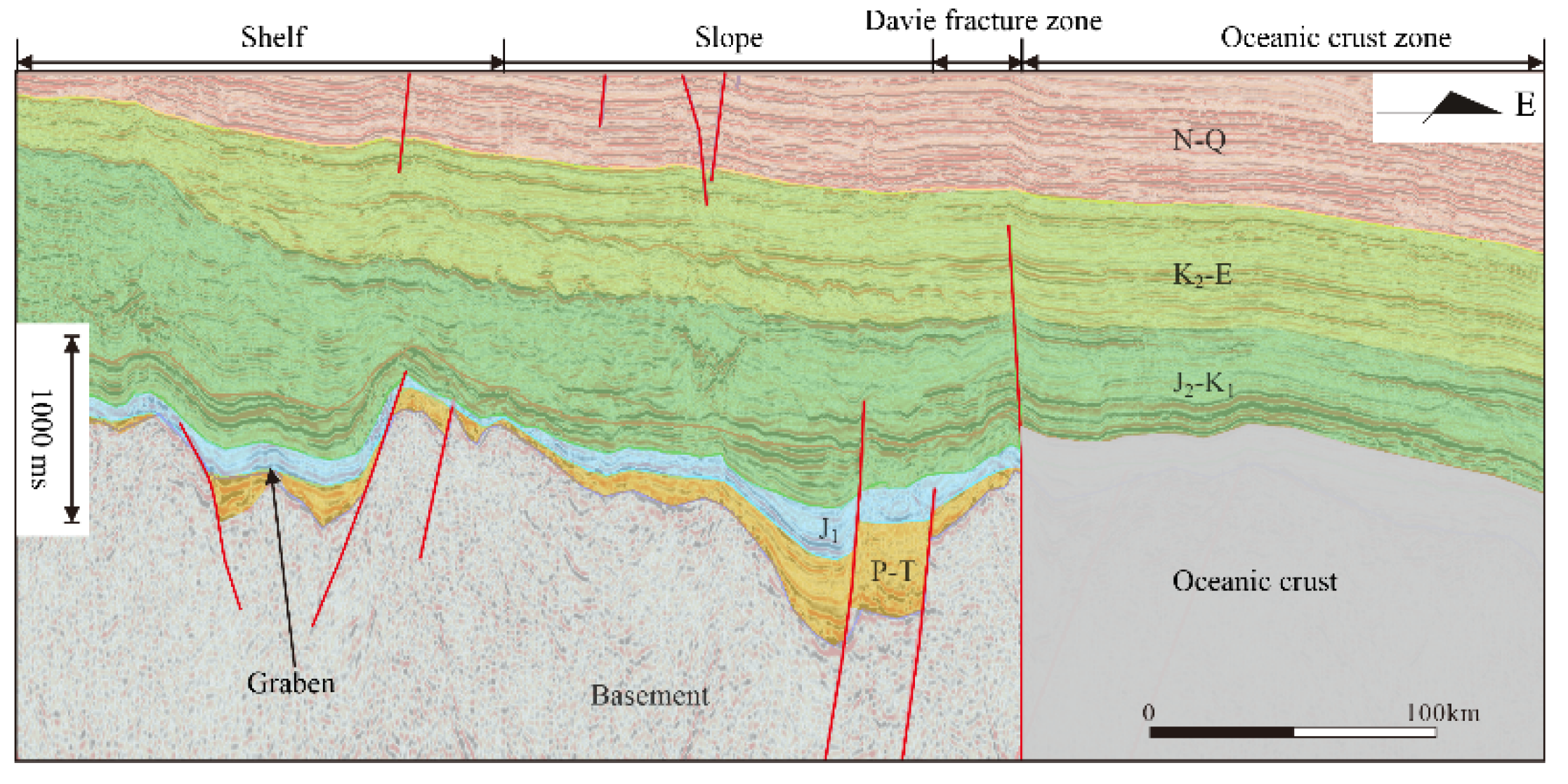

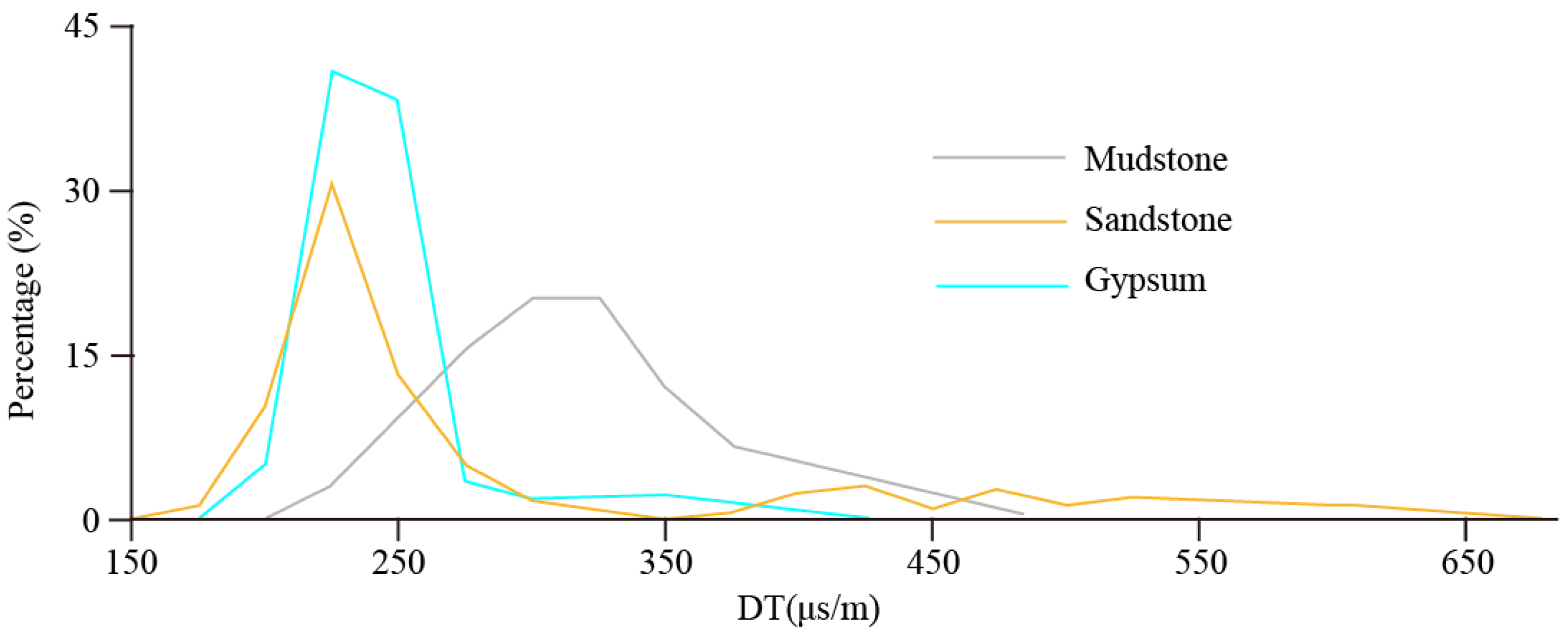
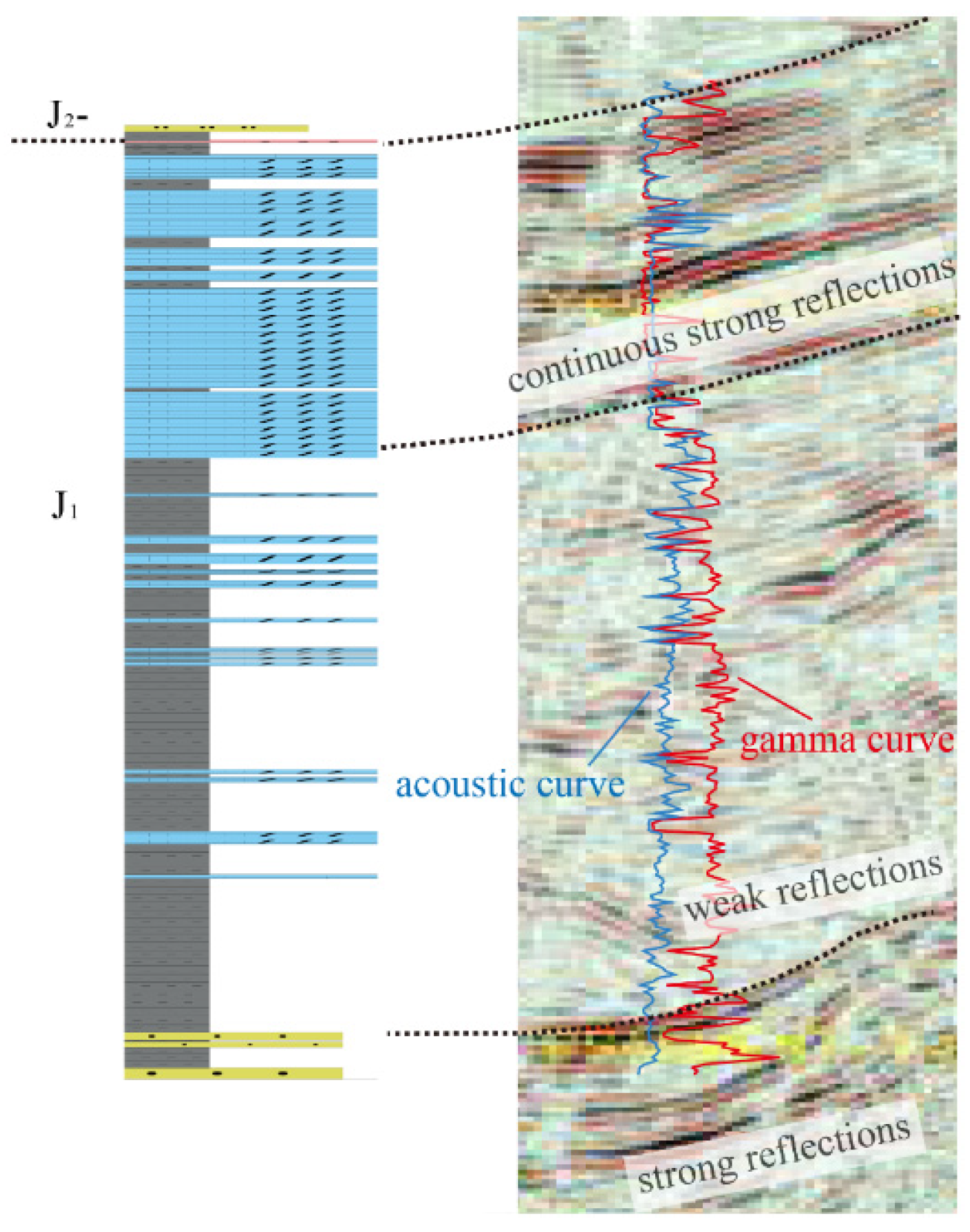

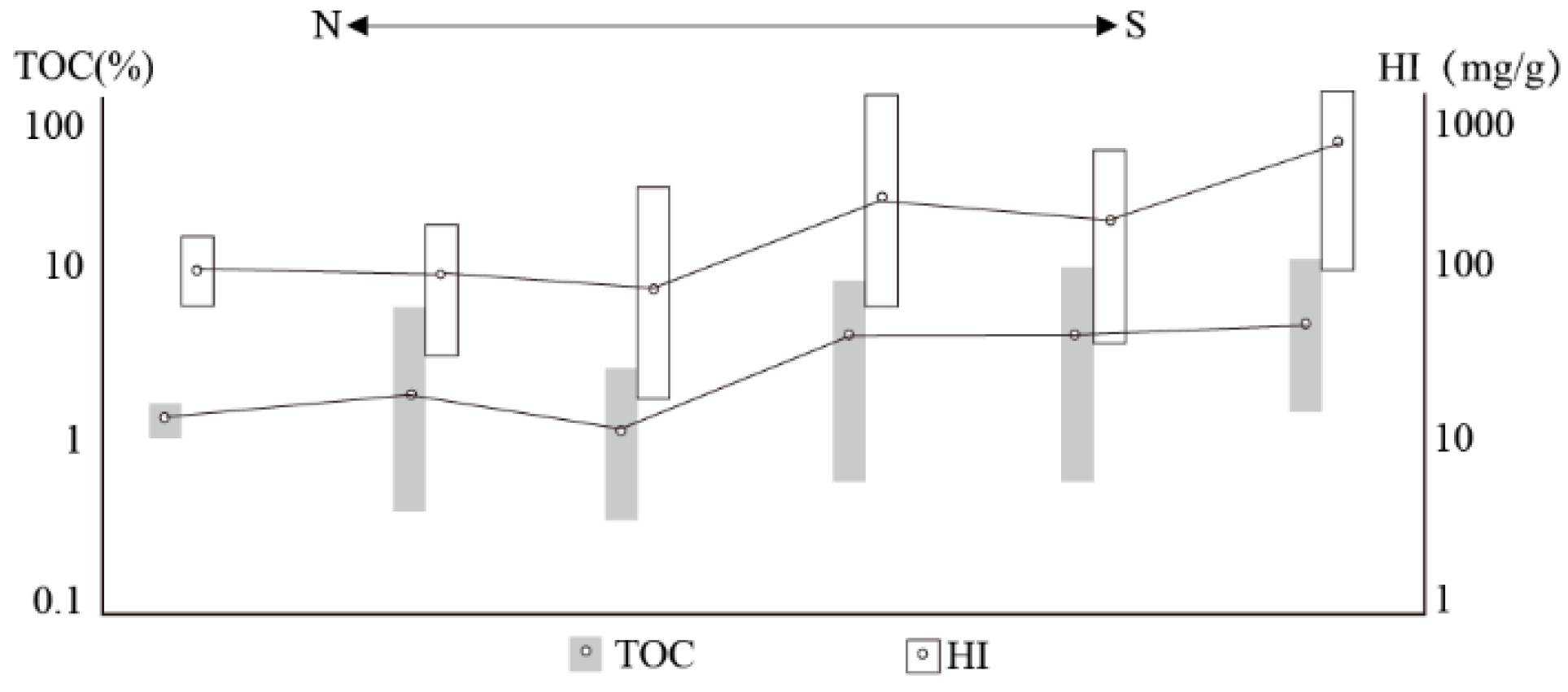
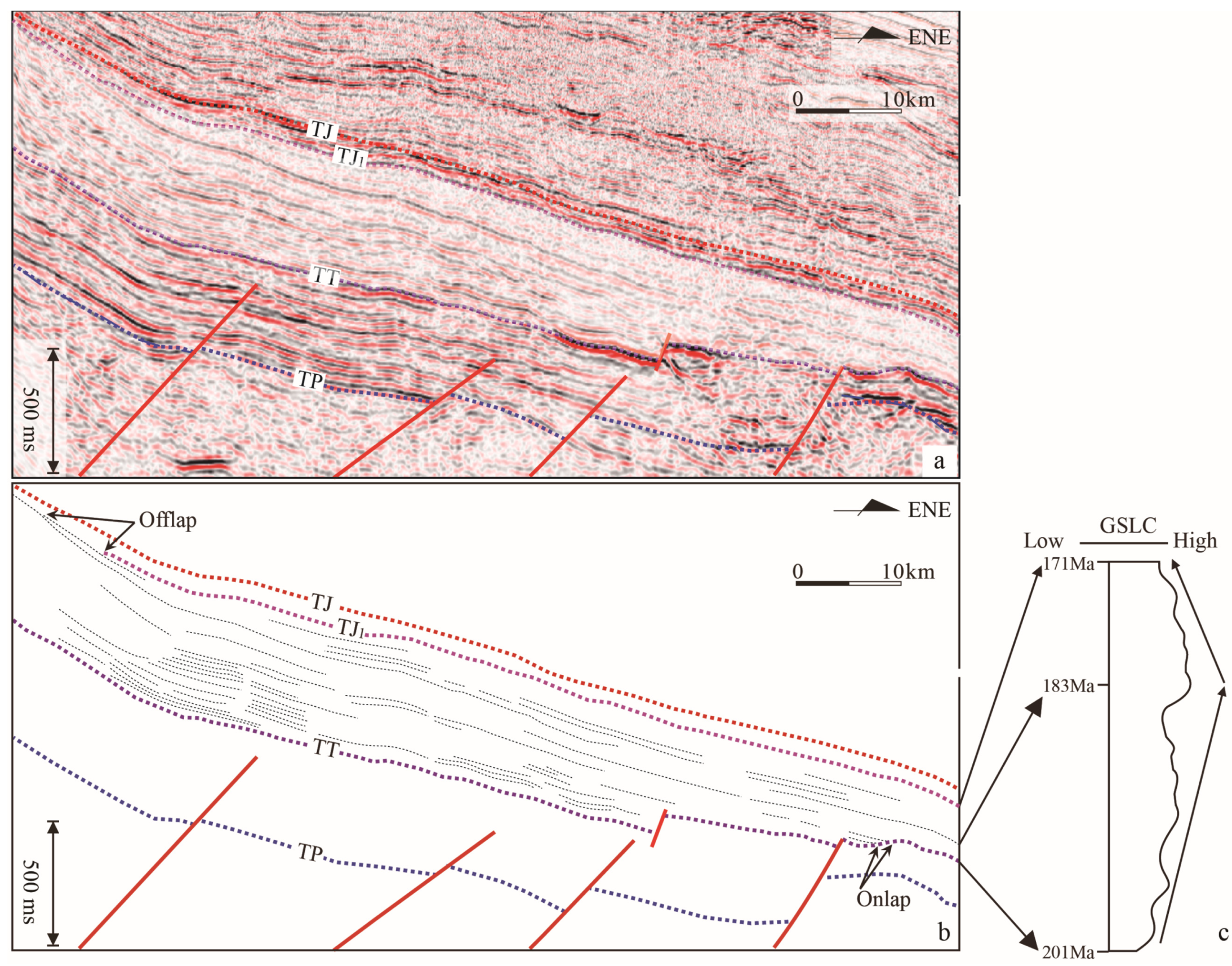
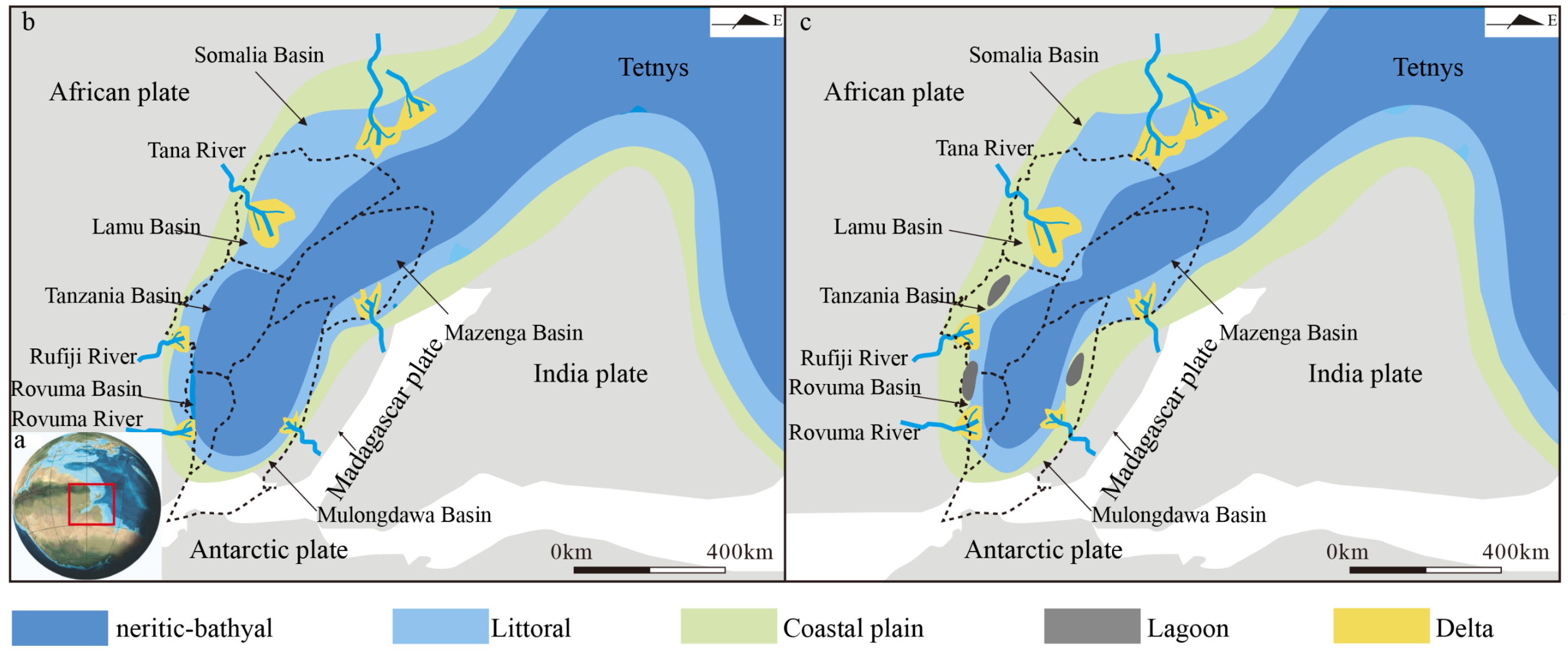

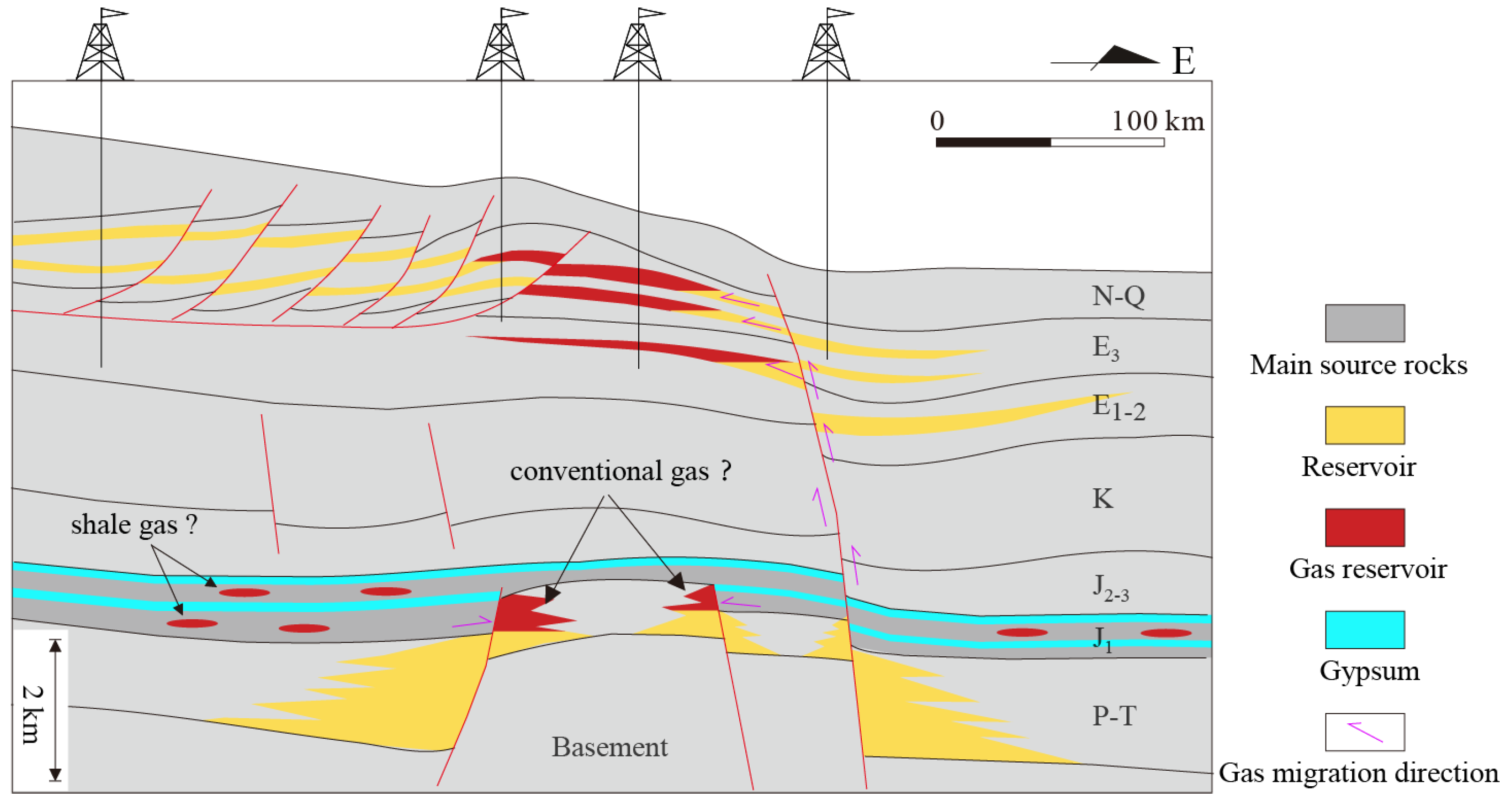
| Lithology | DT (μs/m) | Velocity (m/s) | Density (kg/m3) | Wave Impedance (kg/(s·m)) |
|---|---|---|---|---|
| sandstone | 225 | 4444 | 2620 | 1164.33 × 104 |
| gypsum | 230 | 4348 | 2070 | 900 × 104 |
| mudstone | 315 | 3175 | 2420 | 768.35 × 104 |
Disclaimer/Publisher’s Note: The statements, opinions and data contained in all publications are solely those of the individual author(s) and contributor(s) and not of MDPI and/or the editor(s). MDPI and/or the editor(s) disclaim responsibility for any injury to people or property resulting from any ideas, methods, instructions or products referred to in the content. |
© 2024 by the authors. Licensee MDPI, Basel, Switzerland. This article is an open access article distributed under the terms and conditions of the Creative Commons Attribution (CC BY) license (https://creativecommons.org/licenses/by/4.0/).
Share and Cite
Cai, J.; Guo, R. Early Jurassic Gypsum within Eastern African Continental Marginal Basins and Its Significance for Gas Play. J. Mar. Sci. Eng. 2024, 12, 93. https://doi.org/10.3390/jmse12010093
Cai J, Guo R. Early Jurassic Gypsum within Eastern African Continental Marginal Basins and Its Significance for Gas Play. Journal of Marine Science and Engineering. 2024; 12(1):93. https://doi.org/10.3390/jmse12010093
Chicago/Turabian StyleCai, Jun, and Rong Guo. 2024. "Early Jurassic Gypsum within Eastern African Continental Marginal Basins and Its Significance for Gas Play" Journal of Marine Science and Engineering 12, no. 1: 93. https://doi.org/10.3390/jmse12010093
APA StyleCai, J., & Guo, R. (2024). Early Jurassic Gypsum within Eastern African Continental Marginal Basins and Its Significance for Gas Play. Journal of Marine Science and Engineering, 12(1), 93. https://doi.org/10.3390/jmse12010093





